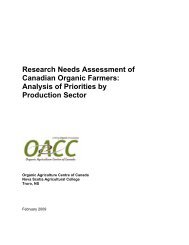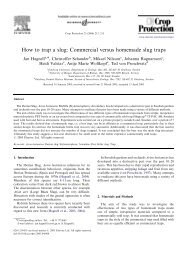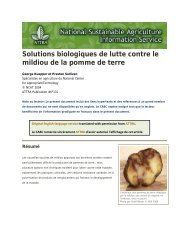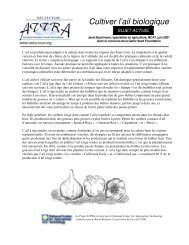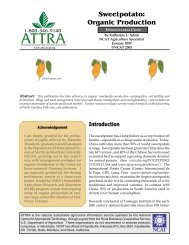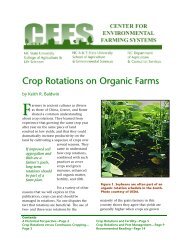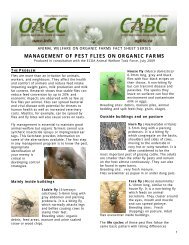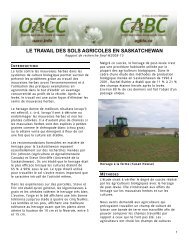Create successful ePaper yourself
Turn your PDF publications into a flip-book with our unique Google optimized e-Paper software.
and grasses can provide benefits betweenthe harvest of spring vegetable crops andthe planting of fall vegetables or smallgrains. While additional legumes andgrasses are being evaluated <strong>for</strong> use, thefollowing species are currently the bestoptions.Summer LegumesCowpea (Vigna unguiculata). Othercommon names <strong>for</strong> this species areblackeyed, crowder, and southern pea.Cowpea is a fast growing, summer covercrop that adapts to a wide range of soilconditions. Cowpeas have a deep taproot,tolerate drought, and compete well againstweeds. Cowpeas produce 3,000 to 4,000pounds of dry biomass per acre, whichcontains 3 to 4 percent nitrogen. Maximumbiomass is achieved in 60 to 90 days.Residues are succulent and decomposereadily when incorporated into the soil.Cowpeas can be planted in the spring (afterall danger of frost) through late summer.Cowpea seeds can be drilled in rows 6 to 8inches apart at 40 pounds per acre or broadcastat approximately 75 pounds per acre.Higher seeding rates are necessary in latesummer when soil moisture is likely to belimited. Recommended cultivars includeIron Clay and Red Ripper. Plants normallygrow up to 24 inches tall, but some cultivarscan climb when planted in mixtureswith other species. Good mixture optionsare sorghum-sudangrass and Germanfoxtail millet. When mowed or undercut,cowpeas have the potential <strong>for</strong> considerableregrowth in some years.Soybean (Glycine max). Soybean is one ofthe most economical choices <strong>for</strong> a summerlegume cover crop. It is an erect, bushyplant that grows 2 to 4 feet tall, establishesquickly, and competes well with weeds.When grown as a green manure crop, latematuring cultivars usually give the highestbiomass yield and fix the most nitrogen. Ifwell established, soybean will withstandshort periods of drought. The viney, <strong>for</strong>agetypes (<strong>for</strong> example, the cultivars Quailhavenand Laredo) have the potential toproduce more biomass than traditionalsoybean cultivars.Velvetbean (Mucuna deeringiana).Velvetbean is a vigorously growing, warmseasonannual legume native to the tropicsand well adapted to southern U. S. conditions.It per<strong>for</strong>ms well in sandy and infertilesoils. Most cultivars are viney, andstems can grow as much as 10 meters.Velvetbean is an excellent green manurecrop, producing high amounts of biomassthat decompose readily to provide nitrogen<strong>for</strong> a cash crop. Velvetbean does best whendirect-seeded into warm soils in 38-inchrows. Velvetbean seed should not bedrilled, because the very large seed can bedamaged in conventional drills.Sunnhemp (Crotalaria juncea). Sunnhempis a tall, herbaceous, warm-season annuallegume with erect fibrous stems. It has beenused extensively <strong>for</strong> soil improvement andgreen manuring in the tropics. It competeswith weeds, grows rapidly, and can reach aheight of 8 feet in 60 days. It can toleratepoor, sandy soils and drought, but requiresgood drainage. Sunnhemp toleratesmoderate acidity, but a soil pH below 5 canlimit growth. Sunnhemp should be drilledor seeded in rows 38 inches apart at 30pounds per acre. The growing season in thecontinental U.S. is not long enough toproduce viable seed. Sunnhemp becomesfibrous with age, but the plants aresucculent <strong>for</strong> about eight weeks afterseeding. Sunnhemp is often planted inmidsummer after cool-season vegetables orsweet corn crops are harvested. It willproduce high biomass and biomass<strong>Organic</strong> Production—<strong>Cover</strong> <strong>Crops</strong> <strong>for</strong> <strong>Organic</strong> <strong>Farms</strong> 15



